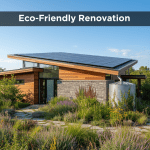
Modern interior design is no longer just a trend; it has become a crucial element in enhancing the functionality, aesthetics, and overall environment of commercial spaces. Businesses are increasingly investing in modern renovations to attract clients, boost employee productivity, and create a lasting impression. In this blog, we explore key ideas and strategies to transform your commercial building interiors into spaces that are both stylish and practical.
1. Open-Plan Layouts with Strategic Zoning
Modern commercial interiors often favor open-plan layouts, breaking down unnecessary walls to create spacious, flexible environments. However, completely open spaces can lack privacy and organization. Strategic zoning—using glass partitions, furniture arrangements, or area rugs—helps delineate different areas while maintaining an open and airy feel. This approach encourages collaboration, enhances natural light flow, and gives your commercial space a contemporary edge.
2. Incorporating Sustainable and Eco-Friendly Materials
Sustainability is a core component of modern interior design. Commercial buildings can benefit from eco-friendly materials such as bamboo flooring, reclaimed wood, recycled metal accents, and low-VOC paints. Not only do these materials reduce the environmental impact of renovations, but they also contribute to a healthier indoor environment, which is increasingly valued by employees and clients alike.
3. Smart Office Technology Integration
The integration of smart technology has revolutionized commercial interiors. Modern buildings now incorporate intelligent lighting systems, automated climate control, and energy-efficient appliances. Interactive displays, wireless charging stations, and IoT-enabled meeting rooms improve operational efficiency and create a cutting-edge experience for visitors. Investing in technology-driven renovations ensures that your commercial space stays relevant in a competitive market.
4. Flexible Workspaces and Multi-Functional Areas
Modern commercial interiors prioritize flexibility. Movable furniture, modular workstations, and adaptable meeting rooms allow the space to accommodate varying needs. A cafeteria that doubles as a collaborative workspace, or a lounge area that converts into a seminar venue, exemplifies how modern design emphasizes versatility. Such renovations increase space utilization and create an environment that evolves with your business.
5. Biophilic Design and Indoor Greenery
Modern interior renovations increasingly embrace biophilic design—the incorporation of natural elements indoors. Indoor plants, green walls, and natural materials create a calming and visually appealing environment. Studies show that exposure to greenery in the workplace reduces stress and improves productivity. For commercial buildings, introducing natural elements not only enhances aesthetics but also promotes employee well-being and satisfaction.
6. Minimalist Aesthetic with Bold Accents
A hallmark of modern interior design is minimalism. Clean lines, uncluttered spaces, and neutral color palettes provide a sophisticated canvas. To avoid monotony, bold accents such as colorful furniture, feature walls, or artistic installations can be strategically placed to create visual interest. Minimalist design ensures that the space feels expansive and organized while maintaining a professional look suitable for commercial purposes.
7. Optimizing Lighting for Ambiance and Functionality
Lighting plays a pivotal role in modern commercial interiors. Natural light should be maximized through large windows and skylights, while LED fixtures provide energy-efficient solutions for artificial illumination. Task lighting in work areas, accent lighting for displays, and ambient lighting in communal spaces create a dynamic and functional environment. Modern renovations focus on layered lighting to balance aesthetics with productivity.
8. Customized Branding Elements
Modern commercial spaces increasingly incorporate branding directly into the interior design. Custom wall graphics, logo installations, branded furniture, and thematic color schemes reinforce a company’s identity and values. A well-branded interior creates a memorable impression on clients and fosters a sense of pride among employees, making it an essential component of any modern renovation strategy.
9. Acoustic Solutions for Comfort and Privacy
Noise management is crucial in modern open-plan offices. Acoustic panels, sound-absorbing partitions, and soft furnishings help reduce distractions and create a comfortable working environment. Integrating soundproof meeting rooms and quiet zones ensures that your commercial space is both collaborative and focused—a key consideration in modern interior renovations.
Conclusion
Modern interior renovation ideas for commercial buildings go beyond aesthetics; they enhance functionality, sustainability, and employee satisfaction. By incorporating open-plan layouts, smart technology, biophilic elements, minimalist design, and flexible spaces, businesses can transform their interiors into inspiring, efficient, and welcoming environments. Investing in modern renovations is not just a design choice—it’s a strategic decision that pays dividends in productivity, client perception, and long-term value.
Ready to Build with Confidence?
Get in touch with Charminar to learn how our project management expertise can streamline your next development.
📧 contact@bluediamondfm.com
📞 +971 56 705 4223
🌐 https://charminardubai.com/
Frequently Asked Questions (FAQ)
What does “modern interior renovation” mean for commercial buildings?
Modern interior renovation focuses on updating commercial spaces with contemporary design elements, sustainable materials, smart technology, flexible layouts, and efficient use of space. The goal is to create an environment that is functional, visually appealing, and aligned with current trends.
Why is modern interior design important for businesses?
Modern design improves employee productivity, client perception, and overall workplace satisfaction. It also allows for better space utilization, energy efficiency, and a professional atmosphere that reflects your company’s brand and values.
How much does a modern commercial renovation typically cost?
Costs vary depending on the size of the space, materials used, and complexity of the design. Simple updates like painting, lighting, and furniture upgrades are more affordable, while large-scale structural changes and tech integration require a higher investment.
Can small commercial spaces benefit from modern interior renovation?
Absolutely. Even smaller offices can feel spacious and functional with smart layouts, minimalistic design, multifunctional furniture, and optimized lighting. Modern renovations can make small spaces appear larger and more inviting.
How long does a modern interior renovation usually take?
The timeline depends on the scale of the project. Minor updates may take a few weeks, while full-scale renovations—including structural changes, technology integration, and décor updates—can take several months. Proper planning helps minimize downtime for business operations.







